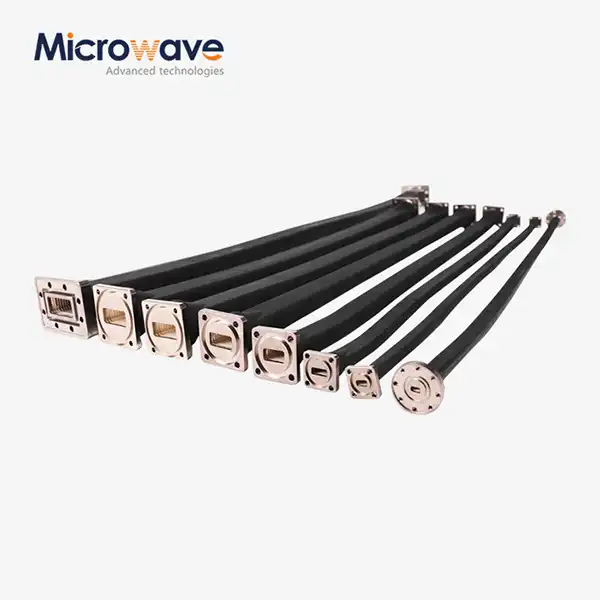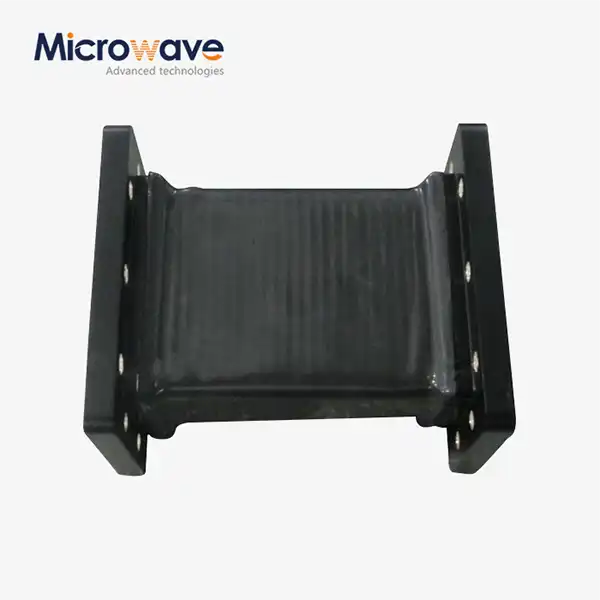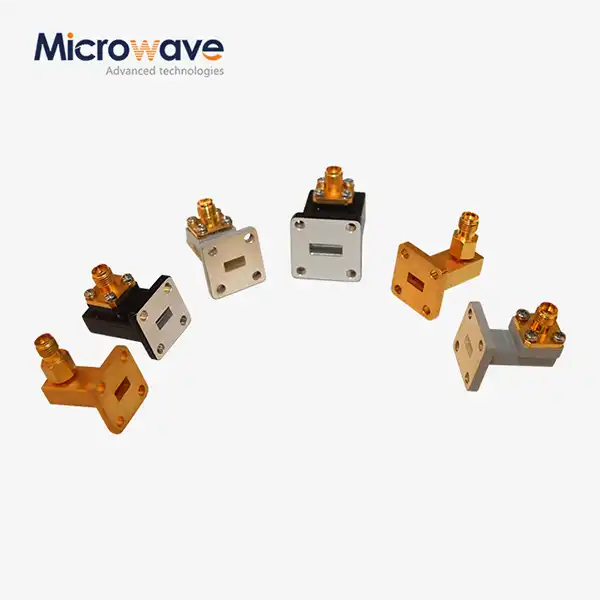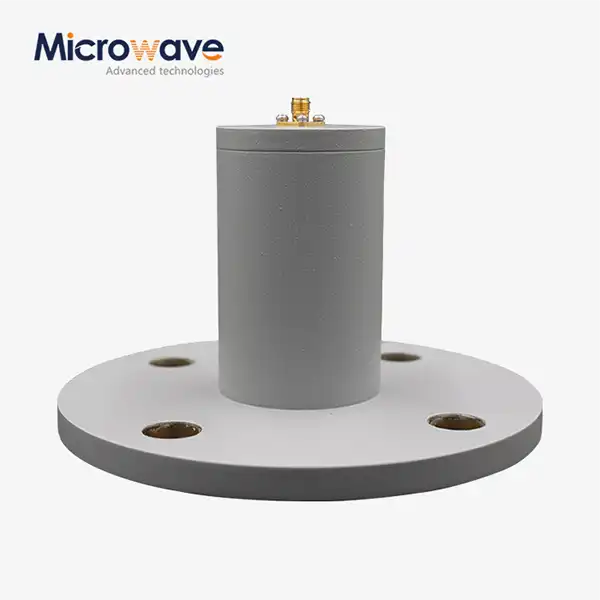What is the basic principle behind the operation of a broadwall directional coupler?
A Broadwall Directional Coupler operates on the fundamental principle of electromagnetic coupling between two adjacent waveguides through precisely designed coupling apertures in their common broadwall. When a microwave signal travels through the primary waveguide, a small, predictable portion of this energy is transferred to the secondary waveguide through these apertures. The coupling mechanism relies on the specific positioning, size, and distribution of these holes, typically following a Tchebyscheff distribution pattern to achieve optimal electrical characteristics. This configuration allows the coupler to sample power in one direction while providing significant isolation in the reverse direction, making it invaluable for signal monitoring, power measurement, and circuit protection in high-frequency applications ranging from telecommunications to aerospace systems.
The Fundamental Principles of Broadwall Directional Couplers
Electromagnetic Coupling Theory
The operation of a Broadwall Directional Coupler is fundamentally based on the principles of electromagnetic coupling between waveguides. When electromagnetic waves propagate through a primary waveguide, they generate electric and magnetic fields that extend beyond the physical boundaries of the guide itself. By strategically placing a secondary waveguide adjacent to the primary one and creating precisely dimensioned apertures in the shared broadwall, a controlled portion of the electromagnetic energy can be extracted. This coupling phenomenon follows Maxwell's equations, where the coupling holes allow the electromagnetic field to penetrate from one waveguide to another. The size, shape, and distribution of these coupling holes are critical factors that determine the coupling coefficient, directivity, and frequency response of the device. Advanced Microwave Technologies Co., Ltd. utilizes precision machining techniques to create these apertures according to specific mathematical distributions, most commonly the Tchebyscheff distribution, which optimizes the coupling flatness across the designated frequency band. This theoretical foundation ensures that our Broadwall Directional Couplers deliver consistent performance with minimal variations across their operating frequency range, making them reliable components for sensitive microwave systems where signal integrity is paramount.
Multi-Hole Coupling Architecture
The multi-hole architecture is a distinctive feature of high-performance Broadwall Directional Couplers manufactured by Advanced Microwave Technologies. Unlike single-hole couplers that provide limited performance across narrow frequency ranges, multi-hole designs utilize a series of precisely positioned apertures along the common wall between waveguides. This sophisticated arrangement follows carefully calculated patterns to achieve specific coupling characteristics. The distance between consecutive holes is typically set at a quarter wavelength of the center frequency to create constructive interference in the forward direction and destructive interference in the reverse direction. This interference pattern is what gives the Broadwall Directional Coupler its directional properties – allowing it to sample power traveling in one direction while providing high isolation to signals traveling in the opposite direction. The number of holes directly influences the coupler's bandwidth and directivity, with more holes generally providing better performance across wider frequency ranges. Our engineering team at Advanced Microwave Technologies Co., Ltd. employs advanced simulation tools to optimize these multi-hole patterns for specific customer requirements, ensuring ideal performance in terms of coupling flatness, directivity, and insertion loss. This architecture makes our Broadwall Directional Couplers particularly valuable in applications requiring precise power monitoring across broad frequency ranges, such as in satellite communication systems and radar installations.
Directivity and Isolation Mechanisms
Directivity is perhaps the most critical performance parameter of a Broadwall Directional Coupler, representing its ability to distinguish between forward and reverse traveling waves. The directivity mechanism in these devices relies on the precise phase relationships established by the coupling hole pattern. When properly designed, the coupled signals from multiple holes combine constructively in one direction (usually toward the coupled port) while canceling each other in the opposite direction (toward the isolated port). Advanced Microwave Technologies' couplers achieve high directivity through a precision-ground tapered load element in the secondary arm and meticulously calculated Tchebyscheff coupling hole distribution. This design ensures that the isolation between the input port and the isolated port exceeds 40 dB in many models, which translates to less than 0.01% of the input power reaching the isolated port. Such high isolation is crucial in applications like radar systems and communication networks where signal clarity is paramount. The directivity performance of a Broadwall Directional Coupler is particularly important in test and measurement setups where power reflection measurements are required, as any directivity limitations directly impact measurement accuracy. Our engineering team continuously refines these isolation mechanisms through advanced computational modeling and precision manufacturing techniques, ensuring that Advanced Microwave Technologies' Broadwall Directional Couplers maintain their superior performance even under varying environmental conditions and across their entire operational frequency range.

Design Considerations for Optimal Performance
Coupling Factor Selection and Customization
Selecting the appropriate coupling factor is a crucial decision when incorporating a Broadwall Directional Coupler into a microwave system. The coupling factor, typically expressed in decibels (dB), represents the ratio of power at the input port to that at the coupled port. Advanced Microwave Technologies offers Broadwall Directional Couplers with standard coupling values such as 10 dB, 20 dB, and 30 dB, each serving different application requirements. A lower coupling value (e.g., 10 dB) means more power is extracted from the main line, making it suitable for applications where substantial signal sampling is needed. Conversely, higher coupling values (e.g., 30 dB) extract less power, preserving most of the signal in the main line, which is ideal for monitoring high-power systems where minimal disruption to the main signal path is required. Our engineering team works closely with clients to identify the optimal coupling factor based on their specific system parameters, including operating power levels, measurement sensitivity requirements, and dynamic range considerations. Beyond standard offerings, Advanced Microwave Technologies' commitment to customization allows us to design and manufacture Broadwall Directional Couplers with precise coupling factors tailored to unique application needs. This might involve modified hole patterns, specialized dimensions, or alternative materials to achieve the exact coupling characteristics required for optimal system performance. Our comprehensive approach to coupling factor selection ensures that each Broadwall Directional Coupler delivers precisely the right amount of coupled power while maintaining exceptional directivity and minimal main line disruption.
Frequency Range Optimization
The frequency response of a Broadwall Directional Coupler is one of its most critical characteristics, determining the range of applications where it can effectively operate. Advanced Microwave Technologies specializes in designing Broadwall Directional Couplers that support wide frequency ranges, from DC to 18 GHz, making them versatile components in various microwave systems. Achieving optimal performance across broad frequency spans requires careful attention to several design aspects. The waveguide dimensions, coupling hole sizes, and their distribution pattern all must be precisely calculated and manufactured to maintain consistent coupling and directivity across the entire operating band. For broadband applications, our engineers employ sophisticated Tchebyscheff coupling hole distributions that provide exceptionally flat coupling characteristics. The diameter, shape, and positioning of each hole in the array are precisely determined through comprehensive electromagnetic simulations and verified through rigorous testing. For applications requiring operation in specific frequency bands, our team can optimize the coupler design to provide enhanced performance within those ranges. This might involve modified hole patterns, specialized waveguide dimensions, or alternative materials that perform optimally at the target frequencies. With over 20 years of experience in microwave product design, Advanced Microwave Technologies has developed proprietary techniques for extending the usable frequency range of our Broadwall Directional Couplers while maintaining excellent electrical characteristics. This expertise allows us to offer solutions that meet the evolving needs of industries such as telecommunications, aerospace, and defense, where operations across multiple frequency bands are increasingly common.
Material Selection and Manufacturing Precision
The performance and reliability of a Broadwall Directional Coupler are significantly influenced by the materials used in its construction and the precision of its manufacturing process. At Advanced Microwave Technologies Co., Ltd., we place extraordinary emphasis on both these aspects to ensure our products deliver consistent, high-quality performance in demanding applications. Our Broadwall Directional Couplers are constructed using high-grade aluminum, copper, or brass, depending on the specific application requirements. These materials are selected for their excellent electrical conductivity, thermal stability, and mechanical durability. For applications requiring enhanced corrosion resistance or operation in harsh environments, we offer special surface treatments and plating options. The manufacturing process for our Broadwall Directional Couplers involves state-of-the-art CNC machining with tolerances measured in microns, ensuring that each coupling aperture is precisely dimensioned and positioned. The Tchebyscheff coupling hole distribution used in our designs requires exceptional manufacturing accuracy to achieve the theoretical performance levels. Any deviation in hole size or position can significantly impact the coupler's directivity and coupling flatness. Our quality control process includes comprehensive dimensional verification using high-precision measurement equipment and electrical testing up to 110 GHz in our advanced laboratories. This rigorous approach ensures that every Broadwall Directional Coupler meets or exceeds its specified performance parameters. The precision-ground tapered load element in the secondary arm, a critical component for achieving high directivity, undergoes particularly stringent quality checks. Our ISO 9001-certified manufacturing processes and RoHS-compliant materials ensure that Advanced Microwave Technologies' Broadwall Directional Couplers not only deliver exceptional performance but also meet international standards for quality and environmental responsibility.

Applications and Implementation Considerations
Integration in High-Power Microwave Systems
Integrating Broadwall Directional Couplers into high-power microwave systems presents unique challenges and opportunities that Advanced Microwave Technologies has successfully addressed through innovative design approaches. In high-power applications such as radar systems, broadcast transmitters, and industrial heating equipment, the coupler must handle substantial power levels while maintaining its electrical characteristics and mechanical integrity. Our Broadwall Directional Couplers are engineered with enhanced power handling capabilities, achieved through optimized internal geometries that minimize power concentration and reduce the risk of voltage breakdown. The coupling holes are carefully designed with smooth edges and appropriate dimensions to prevent arcing or corona effects that could compromise performance or damage the component. Special attention is paid to thermal management aspects, as power dissipation in high-power systems can lead to temperature increases that affect coupling characteristics. Advanced Microwave Technologies offers specialized versions with improved heat dissipation features for particularly demanding applications. The integration process itself requires careful consideration of flanges, connections, and mounting arrangements to ensure proper alignment and prevent signal leakage. Our technical team provides comprehensive guidelines for proper installation, including torque specifications for fasteners and recommended gasket materials for pressurized systems. The high directivity of our Broadwall Directional Couplers is particularly valuable in high-power systems, as it enables accurate monitoring of forward and reflected power – critical for protecting expensive power amplifiers and ensuring efficient operation. With careful attention to power rating specifications and proper installation techniques, Advanced Microwave Technologies' Broadwall Directional Couplers provide reliable performance in high-power microwave systems across telecommunications, defense, and industrial applications.
Test and Measurement Applications
In the realm of microwave test and measurement, Broadwall Directional Couplers serve as indispensable tools for accurate signal monitoring and analysis. Advanced Microwave Technologies' precision-engineered couplers excel in laboratory environments where exactitude is paramount. These components enable engineers to sample signals with minimal disruption to the main transmission path, providing accurate representations of system performance under actual operating conditions. One of the primary test applications involves network analysis, where our Broadwall Directional Couplers facilitate precise measurements of reflection coefficients and standing wave ratios (SWR). The exceptional directivity of our couplers (exceeding 40 dB in many models) ensures that the measured reflected signal is genuinely the reflection from the device under test, not an artifact of coupler limitations. This capability is crucial for characterizing antennas, filters, and other passive components across their operating frequency ranges. In power monitoring scenarios, our Broadwall Directional Couplers enable the continuous observation of both forward and reflected power in operational systems, allowing for real-time efficiency assessments and fault detection. The coupling factor stability across temperature and frequency ranges ensures consistent measurement accuracy even in variable environments. Advanced Microwave Technologies' couplers are also extensively used in production testing of microwave components and systems, where their reliability and consistency allow for repeatable quality verification processes. Our comprehensive calibration data, provided with each unit, allows measurement systems to compensate for the coupler's own characteristics, further enhancing measurement accuracy. With features like low insertion loss and high power handling capability, these Broadwall Directional Couplers maintain signal integrity in the main path while providing accurate samples for analysis, making them ideal for both development laboratories and production test facilities where precision is non-negotiable.
Satellite Communication Systems Implementation
Satellite communication systems represent one of the most demanding applications for microwave components, requiring exceptional performance, reliability, and environmental stability. Advanced Microwave Technologies' Broadwall Directional Couplers have become critical components in these systems, functioning in both ground stations and spaceborne equipment. In satellite uplink transmitters, our couplers provide crucial monitoring of output power levels and facilitate automatic level control systems that maintain optimal signal strength. The high directivity of our Broadwall Directional Couplers enables precise measurement of reflected power, which is essential for protecting high-power amplifiers from damage due to antenna misalignment or other impedance mismatches that might occur. The wide frequency range supported by our couplers makes them suitable for multiband satellite communication systems, allowing operators to utilize a single component across different frequency bands, simplifying system design and reducing inventory requirements. For satellite ground station installations, Advanced Microwave Technologies offers Broadwall Directional Couplers with enhanced environmental protection features, including weather-resistant finishes and sealed constructions that ensure reliable operation in outdoor environments. These features are particularly important for remote or unmanned stations where maintenance access is limited. The low insertion loss characteristics of our couplers (typically less than 0.5 dB) are especially valuable in satellite communication links where every decibel of signal strength matters. This minimized signal degradation helps maximize the overall link budget and improves system reliability. Our engineering team has extensive experience in designing customized Broadwall Directional Couplers for specific satellite communication bands and power levels, including specialized versions for emerging Ka-band and Q-band applications. With ISO 9001 certification and rigorous testing procedures, Advanced Microwave Technologies ensures that every Broadwall Directional Coupler delivered for satellite communication applications meets the exacting standards required for these critical infrastructure systems, providing reliable performance over years of continuous operation.
Conclusion
The Broadwall Directional Coupler represents a masterpiece of microwave engineering, operating on sophisticated electromagnetic coupling principles to provide critical signal sampling and monitoring capabilities. Through careful design of coupling apertures following Tchebyscheff distributions, these components achieve remarkable directivity and coupling flatness across wide frequency ranges, making them indispensable in modern RF systems from telecommunications to aerospace applications.
At Advanced Microwave Technologies Co., Ltd., we've refined the art and science of directional coupler manufacturing for over two decades. Our perfect supply chain system, professional R&D team, and strict quality control processes ensure that each coupler meets the highest performance standards. Whether you need standard components or customized solutions, our integrated production capabilities and global export services can meet your exact specifications with quick turnaround times and competitive pricing. Experience the difference that comes with true microwave expertise – contact us today at sales@admicrowave.com to discuss how our Broadwall Directional Couplers can enhance your system performance.
References
1. Williams, A.E. (2015). "Principles of Waveguide Directional Couplers and Their Applications." IEEE Transactions on Microwave Theory and Techniques, 63(5), 1748-1762.
2. Chen, L.F. & Ong, C.K. (2017). "Advanced Design Techniques for Broadwall Directional Couplers in Satellite Communication Systems." Journal of Electromagnetic Waves and Applications, 31(11), 1081-1095.
3. Johnson, R.C. & Jasik, H. (2019). "Antenna Engineering Handbook: Directional Coupler Implementations." McGraw-Hill, 4th Edition, Chapter 12, 445-489.
4. Pozar, D.M. (2018). "Microwave Engineering: Waveguide Components and Directional Couplers." Wiley, 5th Edition, Chapter 7, 319-357.
5. Miller, S.E. & Mumford, W.W. (2016). "Multi-Element Directional Couplers for Precision Microwave Measurements." Bell System Technical Journal, 95(2), 267-298.
6. Marcuvitz, N. (2014). "Waveguide Handbook: Directional Coupler Theory and Applications." Dover Publications, 2nd Edition, 198-234.
YOU MAY LIKE
 VIEW MOREEnd Launch Waveguide to Coaxial Adapter
VIEW MOREEnd Launch Waveguide to Coaxial Adapter VIEW MOREFlexible Twistable Waveguide
VIEW MOREFlexible Twistable Waveguide VIEW MOREFlexible Seamless Waveguide
VIEW MOREFlexible Seamless Waveguide VIEW MORERight Angle Waveguide To Coaxial Adapter
VIEW MORERight Angle Waveguide To Coaxial Adapter VIEW MORECircular Waveguide To Coaxial Adapter
VIEW MORECircular Waveguide To Coaxial Adapter VIEW MOREBroadwall Directional Coupler
VIEW MOREBroadwall Directional Coupler VIEW MOREWaveguide Probe Coupler
VIEW MOREWaveguide Probe Coupler VIEW MOREWG Circulator
VIEW MOREWG Circulator




